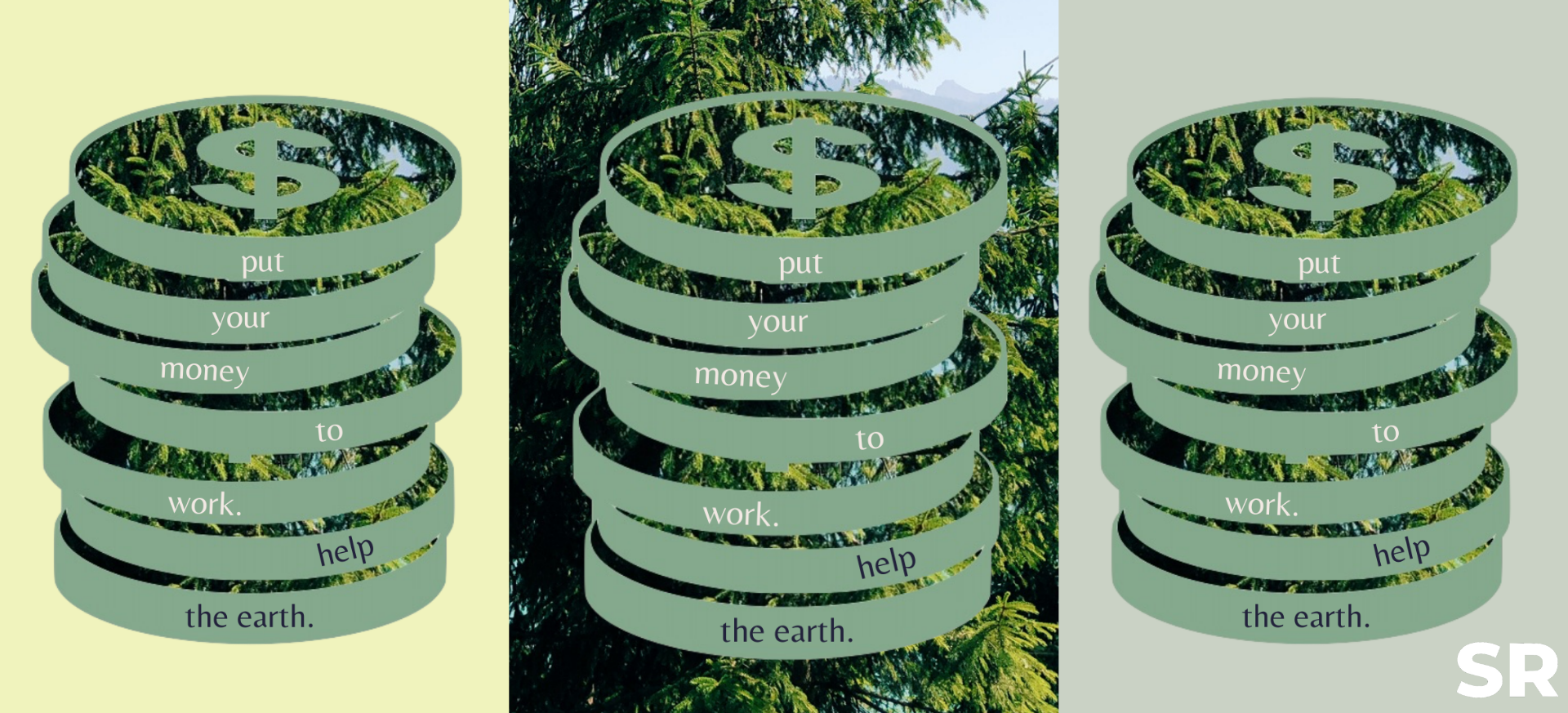With sustainable investing, you can support clean tech development, human rights, and gender equality… all at the same time.
Let your money do the work. Here’s how.
Busy? Try the speed read.
What to know Sustainable investing allows you to implement your core values while increasing your profits. ETFs, Index Funds, and Roboadvisors are a good place to start.
Four main approaches
- Exclusionary screening – avoiding investment in companies or sectors that do not align with investor values.
- ESG integration – rating companies based on their implementation of Environmental, Social and Governance principles.
- Thematic investing – focusing investments according to interest in specific themes, for example clean energy.
- Impact investing – investing in companies or funds with the intention of generating impact alongside a financial return.
Bottom line — Sustainable investing not only offers you a way to invest according to your values, but it also provides good financial performance and potential risk mitigation.
Dig deeper —> 5 min
Getting started with sustainable investing
In the financial industry, we colloquially call investing putting money to work. Sustainable investing is an investment strategy that allows you to implement core values while increasing profits.
This strategy changes how you think about the power of money and investing. Spit a big ‘social justice’ game? This is the definition of putting your money where your mouth is.
You might have already heard of many vague terms surrounding this concept. Some refer to it as socially responsible investing, ethical investing, impact investing, principal investing, etc.
The basic idea is to invest while considering environmental, social, and corporate governance (ESG) criteria that will generate positive social impact along with long-term competitive financial returns.
Let’s dive into what sustainable investing means, how it addresses risk, how it performs, and how to get started.
The four main approaches to sustainable investing
To understand sustainable investing, we will first look into the different strategies of how to pick value-aligned companies.
When sustainable investing first emerged onto the world stage, it was mostly implemented in the form of exclusionary screening. Now, other methods such as ESG integration, thematic investing, and impact investing are surfacing.
Exclusionary screening: avoid investing in companies or sectors that do not align with investor values, for example excluding fossil fuels and tobacco
ESG integration: rate companies based on their implementation of ESG principles (see Fig.1) and investing only in companies that have a high ESG score
Thematic Investing: focus investments according to interest in a specific environmental or social theme, such as clean energy, water conservation, education, or healthcare
Impact Investing: invest in companies or funds with the intention of generating positive, measurable social and/or environmental impact alongside a financial return. More specifically, you can also engage in climate impact investing.
Social impact is trending
Sustainable investing is rapidly gaining popularity and momentum. More and more institutional investors such as pension/retirement funds and also retail investors, like you and me, are choosing to invest sustainably.
According to the Global Sustainable Investment Alliance, as of year-end 2017, more than one-fourth of all funds under professional management in the US (about $30.7 trillion) are invested according to sustainable investment strategies, a figure growing 34% annually.
This growth is mainly driven by Europe with $14.1 trillion under management, followed by the US with $12 trillion. Though large institutional investors drive most of this growth, retail investors have already proven to make a difference: they account for 25% of global sustainable investing assets.
Moreover, the first quarter of 2020 alone has seen flows into sustainable strategies of $10.5 billion in the United States, even throughout the COVID-19 market crash.
Good investors consider sustainability
You might fear that to invest sustainably, you have to sacrifice performance.
However, companies who implement ESG strategies into their business models can often better manage long-term risks and potentially enhance returns; for example, by reducing exposure to natural hazards or anticipating regulatory changes (UNPD).
The COVID-19 crisis has shown us how unpredictable events can wreak havoc on unprepared companies and the economy at large. If a company decides to obtain resources locally, for instance, it can better prepare itself to deal with supplier interruptions.
Think about the impact of when China first shut down due to COVID-19.
Some of the risks ESG companies try to plan for include:
- Extreme weather events such as droughts, storms, or floods
- Regulatory changes
- Product and supply chain safety
- Reputational damage or weak financial controls
Mitigating risk
Companies can use sustainability strategies to better manage those long-term risks and position themselves as more attractive investments for long-term investors.
So, put that fear aside because investing according to your values does not have to come at the cost of performance.
In fact, Blackrock released research which shows that ESG portfolios outperformed traditional market benchmarks in the recent market downturn.
In fact, 88% of sustainable indices did better than their non-sustainable counterparts in the first four months of 2020.
Besides performing well, the sustainable funds offering has increased to 350 funds. This gives investors many more options along with the ability to weed out funds that do not meet their ESG or performance standards.
Do funds deliver on their promises?
There is a lot of press about greenwashing: exaggerating the environmental benefits of an action or product.
For example, companies that use the exclusionary approach should not necessarily be labeled as sustainable, as they might still be invested in environmentally or socially harmful activities.
Avoiding greenwashing is difficult but a good start is through researching a company or fund to get a sense of whether they are walking the talk.
Do the fund managers have sustainability experts on their team? Are their companies committed to reducing their own negative impact?
What are the underlying investments, and are the fund managers voting as shareholders to improve ESG within those companies?
Perceptions around climate
Morningstar found in their paper “Investing in Times of Climate Change” that climate-aware funds largely deliver on their promises. In the chart below, each dot represents a fund in this study.
The red line is Morningstar’s Global Total Market Exposure Index (serving as the benchmark). Funds that fall below the line meet the index’s carbon intensity standard; funds above the line blow past it. Carbon intensity measures total emissions divided by revenue.
Figure 2: A comparison of environmentally sustainable funds with Morningstar’s Global Target Market Exposure Index
Virtually all Low Carbon, Ex-Fossil Fuel, and Climate Conscious funds met the index’s carbon intensity standard.
On the other hand, while most Climate Solutions and Clean Energy/Tech funds exhibit higher carbon intensity than the benchmark, this might result from being in an early stage in their transition journey.
For example, many clean energy funds still source part of their energy from carbon intensive sources while they work on developing cleaner solutions.
This is not necessarily bad, as their approach to reducing carbon impact is not to simply avoid fossil fuels but to enhance cleaner methods while keeping their businesses running.
Hence, we recommend you dive deep into each fund’s strategy and understand its timeline and focus.
Start Sustainable Investing
So you decided sustainable investing is in line with your values.
You like the performance prospects and risk mitigation potential, and you want to join the thousands of investors already on this path.
But how do you go about putting your money to work?
It is helpful to consider a few questions before starting your search. However, you do not need to know the answer to all of these right away.
- What goals are you investing for? Are you focusing on retirement or are you also saving for a house, vacation, or your child’s college education?
- What is your risk tolerance and time horizon?
- Do you prefer having access to human advisors? What do you want to spend on fees?
- What are each platform’s underlying investments? How do they compare to their benchmark or other advisors?
There are many ways to invest, and the best way for you will depend on your individual circumstances.
Here are two low-cost, easy investing methods: Roboadvisors and ETFs / index funds.
Meet the Roboadvisor
Meet the digital financial platform that help individuals invest according to their personal goals.
It’s called a roboadvisor, and they are used by many companies in the modern world of finance. These tech-friendly firms use algorithms with little to no human intervention to offer financial advice.
Generally, the Roboadvisor will ask you to complete a survey about your risk tolerance, future goals, spending/saving habits, etc.
With that information, the algorithm will suggest a portfolio and automatically invest the money you deposit into the account. Roboadvisors will usually charge a 0.25-1.00% fee on your account balance.
Here are a few examples of Roboadvisors that offer sustainable investment portfolios: Betterment, Wealthsimple, M1 Finance, and Earthfolio. You can find many great articles comparing platforms online.
ETF and Index Funds
Another option to invest sustainably is by directly purchasing low-cost ETFs and index funds in your brokerage account. These funds are low cost because they are passively managed.
That means that they do not have an active manager who spends time and money looking through individual companies and picking a few, but rather purchases all companies included in an index or benchmark.
Fidelity, for example, has stock, ETF, and mutual fund screeners based on environmental, social, and governance characteristics. There, you can search for funds yourself, or your broker can help you pick what is best for you.
There are many thematic ETFs that specifically focus on themes like water conservation, women’s equality, and clean energy.
With a thematic ETF, you can build a portfolio based on principles. Invest in areas that matter to you and where you see future growth.
Solar energy is a good example. Check out more useful guides on sustainable investing here.
Clearly, the sustainable investing landscape represents a large and growing sector of the investment universe.
ESG-focused companies offer a way to invest according to values while also providing good financial performance and potential risk mitigation.
Investing does not have to be scary. Instead, it can be a powerful tool for the betterment of yourself and the world around you. And that’s how you let your money do the work.













People reacted to this story.
Great article Elena!